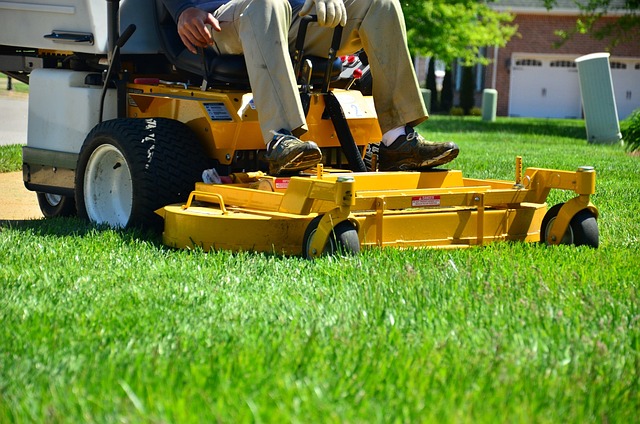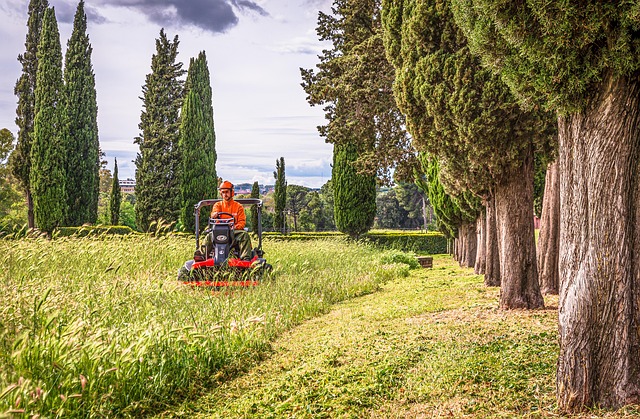Irrigating lawns is key to their health, requiring understanding of grass types, climate, soil, and sunlight. Warm-season grasses need less frequent but deeper watering than cool-season varieties. Efficient irrigation systems, like sprinklers or drip, distribute water tailored to lawn needs, conserving resources. Customized installations by professionals consider slope, vegetation, and regular maintenance for optimal lawn health and water efficiency in Lawn Care and Landscaping.
“Transform your lawn from a simple green space into a thriving oasis with efficient irrigation system installation. This comprehensive guide delves into the essential aspects of lawn care and landscaping, starting with understanding your turf’s unique water requirements. We explore diverse irrigation systems, offering insights to select the perfect fit for your property.
Learn about the step-by-step installation process and unlock tips for maintaining optimal lawn health, ensuring a lush and vibrant exterior that stands out all year round.”
- Understanding Your Lawn's Water Needs: A Comprehensive Guide
- Types of Irrigation Systems: Choosing the Right Fit for Your Property
- Installation Process and Tips for Maintaining an Efficient Lawn Care Routine
Understanding Your Lawn's Water Needs: A Comprehensive Guide

Irrigating your lawn is a significant aspect of effective lawn care and landscaping, ensuring its health, vibrancy, and longevity. Understanding your lawn’s water needs is the first step in installing an efficient irrigation system. Every grass species has unique requirements, and factors like climate, soil type, and exposure to sunlight influence how much water your lawn demands. For instance, warm-season grasses like Bermuda or Zoysia generally require less frequent but deeper watering than cool-season varieties such as Kentucky Bluegrass or Fescues.
Regularly assessing your lawn’s moisture levels and observing its response to rainfall is key to knowing when and how much to water. Tools like moisture sensors and weather stations can provide data-driven insights, helping you tailor irrigation schedules for optimal performance. This personalized approach to lawn care not only conserves water but also promotes a lush, sustainable landscape, contributing to both environmental sustainability and the overall aesthetics of your outdoor space.
Types of Irrigation Systems: Choosing the Right Fit for Your Property

When it comes to irrigation system installation, understanding the diverse types available is key to enhancing your lawn care and landscaping efforts. The right system can transform your property, ensuring lush greenery all year round. Two prominent categories are sprinkler systems and drip irrigation. Sprinkler systems, a popular choice for many, use a network of pipes buried beneath the soil, releasing water at strategic points to create a fine mist or stream, effectively quenching plant roots. This method is ideal for large areas as it covers extensive spaces uniformly.
On the other hand, drip irrigation, often more subtle and efficient, involves placing tiny emitters on the surface or slightly below, allowing water to trickle directly onto plant roots. This targeted approach conserves water significantly and makes it perfect for smaller gardens or regions with water scarcity. Each system has its advantages, catering to different needs, climates, and landscapes. Choosing the right one will ensure optimal hydration for your lawn and landscaping features.
Installation Process and Tips for Maintaining an Efficient Lawn Care Routine

The installation process for an efficient irrigation system begins with assessing your lawn’s needs, taking into account factors like soil type, climate, and grass species. Professional installers will design a tailored system that ensures water reaches every corner of your yard evenly. This involves planning the layout of pipes, emitters, and controllers, considering slope and vegetation to maximize water distribution efficiency.
Regular maintenance is key to keeping your lawn thriving with optimal irrigation. Simple tips include checking for leaks, adjusting sprinkler heads as needed, and ensuring the system operates during the coolest parts of the day for better absorption. Regular cleaning of filters and replacing outdated components can also enhance performance. Incorporating these practices into a consistent landscaping routine will not only keep your grass healthy but also promote water conservation by ensuring every drop counts in your lawn care efforts.
Irrigation system installation is a strategic investment in your lawn care and landscaping. By understanding your property’s unique water needs, selecting the appropriate irrigation system, and following proper installation practices, you’ll establish an efficient, sustainable routine. Regular maintenance ensures optimal performance, allowing your lawn to thrive year-round. Embrace the benefits of automated watering for a lush, vibrant outdoor space that requires less manual effort.














